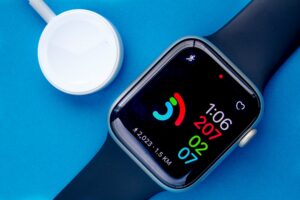
(isak55/Shutterstock)
The integration of artificial intelligence (AI) and machine learning (ML) in healthcare has brought about remarkable advancements in patient care, diagnosis, and treatment. These cutting-edge technologies have revolutionized the healthcare industry, improving accuracy, efficiency, and personalized care. Early disease detection, precision medicine, medical imaging advancements, virtual assistants, and drug discovery are just a few examples of how these technologies are reshaping healthcare practices.
The industry will experience further transformative advancements as AI and ML evolve, empowering healthcare professionals and benefiting patients worldwide. By embracing these technologies responsibly and ethically, providers and patients can unlock the full potential of AI and ML and shape the future of healthcare.
Lessons from a Global Pandemic
The COVID-19 pandemic came with little warning and technology played a vital role in communication, diagnosis, treatment, data security, and epidemiology. Pfizer harnessed AI and ML to create the first vaccines to combat the deadly virus, which were evaluated and authorized for emergency use in under 12 months. Moving forward, clinical trials will harness AI and ML with even greater speed and accuracy to get ahead of future potential pandemics.
In July, the Coalition for Epidemic Preparedness Innovations (CEPI) pledged almost $5 million to a Houston Methodist Research Institute-led consortium identify emerging viruses. In May, the Food and Drug Administration (FDA) released two papers discussing the potential of AI and ML in drug development and manufacturing. According to the FDA, AI and ML “have the potential to transform how stakeholders develop, manufacture, use, and evaluate therapies. Ultimately, AI/ML can help bring safe, effective, and high-quality treatments to patients faster.”
Anticipating Healthcare Problems
Many healthcare companies are already capitalizing on these techniques to help improve their customers’ healthcare. At Johns Hopkins University, an AI system is being used to detect a patient’s risk for sepsis more quickly than through traditional methods. “It is the first instance where AI is implemented at the bedside, used by thousands of providers, and where we’re seeing lives saved,” according to Suchi Saria, founding research director of Johns Hopkins’ Malone Center for Engineering in Healthcare.
This technology could also eventually be applied beyond the healthcare field directly. The Apple Watch, for example, can already monitor a person’s heart rate, blood pressure, and whether the wearer is experiencing any irregular rhythms. With more significant advances in AI and ML, the watch could also be trained to notify wearers if they were going to have a heart attack and tell them to reach out to their physician or to go to the emergency room.
Additionally, chatbots and virtual assistants will be able to help patients in real-time—for example, determining if a child with a fever needs to take some fever-reducing medication or if the child’s symptoms warrant going to the emergency room. The data sets created by AI and ML models are crucial to solving a global pandemic through clinical trials, developing effective vaccines, predicting potential patient problems, and providing more effective diagnoses and improved patient care.
Setting the Parameters
One of the attractions of AI and ML models is that they self-update because they are self-learning. As long as companies have the cloud computing capacity, the more data provided and interactions undertaken with AI, the more quickly the models will be able to provide more accurate answers.
Initially, data science engineers will need to provide the parameters for the data sets to healthcare providers. Using historical data and information from electronic health records (EHRs), training models can be created for someone with a particular health condition, for example. The models can then determine what medications to use, and virtual assistants can generate those prescriptions and medications.
Of course, this also means that those trainings must be done in such a way that Health Insurance Portability and Accountability Act (HIPAA) laws are not broken, patient privacy impact assessment (PIA) is not breached, and personally identifiable information (PII) is omitted. When training the models, it is essential for engineers to ensure they are only inputting the age, gender, occupation, and medical conditions of patients. That means the onus is on the healthcare providers to verify they aren’t including HIPAA or PIA information in the information given to the engineers.
Alleviating Concerns
Some are resistant to entering this brave new world, and that’s understandable. One of the greatest concerns for healthcare providers is privacy. It’s important for providers to create training models specific to their organizations to ensure that the data never leaves their premises. The other primary concern is the accuracy of their data. One negatively impacted patient can destroy an organization. Companies, therefore, should be encouraged to take the necessary time to create their training models. AI may take three to six months to generate and validate accurate results; however, once companies start seeing those accurate results regularly, they can be more confident about the models’ predictions.
The Future is Now
For patients to embrace this new technology, they still want to know that there is a human element and that they can talk to a doctor or nurse if needed. Providers, physicians, nurses, and research scientists are a necessary part of the equation. The healthcare industry directly impacts human beings. That’s why it’s also important to train nurses, physicians, and clinical researchers alongside the data engineers creating the models so that they have a basic understanding of AI and ML and understand how to use historical data correctly.
The possibilities of AI and ML in the industry to make significant inroads in better healthcare are exciting and innovative, offering reduced times to conduct research for clinical trials, delivering potential aid and cures faster to market, supplying telemedicine for remote countries and regions, and providing greater accuracy in predicting patient illnesses. Embracing this fast-growing technology in the industry is crucial for providers and practitioners alike because it creates a future where pandemics can potentially be averted, and insights from AI can generate preventative methods, allowing people to live longer, healthier lives.
 About the Authors: Anil Maktala is a solutions architect at Amazon Web Services. A seasoned IT expert, Anil has over 18 years of experience in software development. His career covers a wide array of industry sectors, including healthcare, publishing, and insurance. Anil’s impact extends to mentoring and guiding numerous engineers, fostering their professional growth and accomplishments. He holds a Bachelor of Technology degree from Jawaharlal Nehru Technological University, India. Connect with Anil on LinkedIn.
About the Authors: Anil Maktala is a solutions architect at Amazon Web Services. A seasoned IT expert, Anil has over 18 years of experience in software development. His career covers a wide array of industry sectors, including healthcare, publishing, and insurance. Anil’s impact extends to mentoring and guiding numerous engineers, fostering their professional growth and accomplishments. He holds a Bachelor of Technology degree from Jawaharlal Nehru Technological University, India. Connect with Anil on LinkedIn. 
Arundeep Nagaraj is a solutions architect manager at AWS. With more than a decade of experience working with global teams, customers and developers, Arundeep has a track record of success leading cross-functional teams, managing complex projects, and delivering products that exceed expectations. Connect with Arundeep on LinkedIn and Twitter.
Related Items:
Putting Data to Work to Deliver the Best Care Everywhere
Data Rx for Healthcare: Security, Real-Time Analytics
Healthcare Agencies Ill-Prepared for Big Data, Report Says






